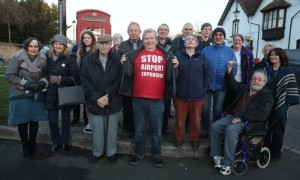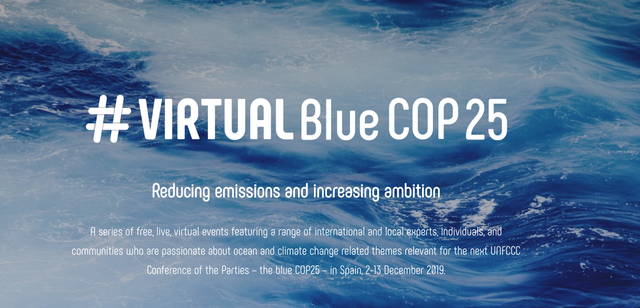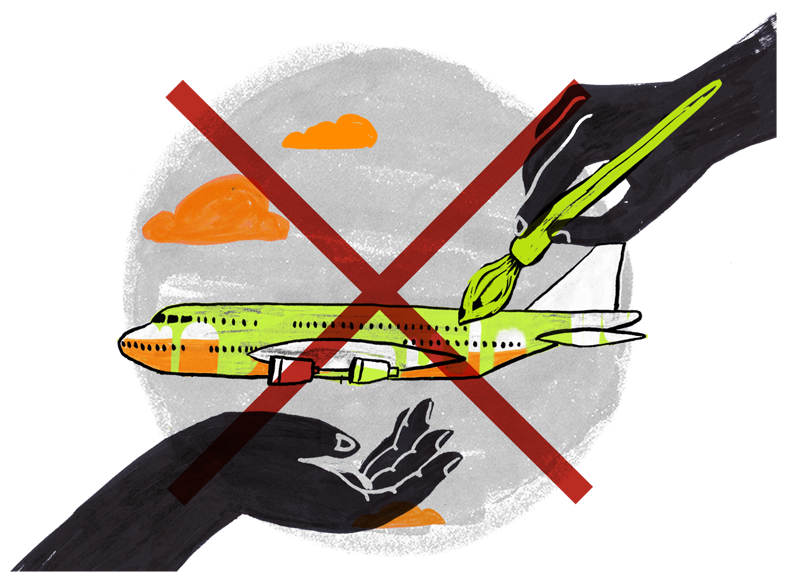The FlyingLess movement, it would seem, has seen its wish fulfilled, and much more quickly than expected: the number of flights worldwide has dropped precipitously in recent weeks.
Tragically, it has taken a global pandemic, to whose spread airlines have been a been a key contributor, to bring about the decrease. As a result, the general economic decline, of which reduced flying is part, has unfolded in a highly disruptive manner that is especially harmful to the already vulnerable. (What’s more, as past experience with reductions associated with economic downturns illustrates, high levels of co2 emissions are likely to return once the threat of COVID-19 passes.)
As anthropologist Jason Hickel points out in relation to the coronavirus-related downturn in industrial activity, “the crucial thing to observe is that this is happening in an unplanned, chaotic way which is hurting people’s lives. . . . What we need,” he says, “is a planned approach to reducing unnecessary industrial activity that has no connection to human welfare and that disproportionately benefits already wealthy people as opposed to ordinary people. There are much more equitable, just and carefully planned ways to approach this kind of problem.” These words certainly apply to our work to achieve far-reaching reductions in flying.
In a time of coronavirus, we continue our efforts—not least because we must in order to minimize the ravages of climate breakdown. We also express our deep sympathies and solidarity with people around the world who have lost loved ones, and who are struggling with their own wellbeing and those around them in the context of the ongoing pandemic. Of course, our sympathies and solidarity are with those suffer from the harms induced by climate change and air pollution as well.
It appears that exposure to air pollution increases the likelihood that one can contract COVID-19. As such, a silver lining of the pandemic—at least a temporary one—is that air pollution levels have dropped dramatically. One sees this in China and South Korea, in cities across the United States, and throughout Europe.
In the case of China alone—for the months of January and February—a research group led by Marshall Burke at Stanford University estimates that the reduction in air pollution “likely has saved the lives of 4,000 kids under 5 and 73,000 adults over 70 in China. This, he states, is “roughly 20x the number of lives that have been directly lost to the virus.”
Lest anyone infer that the researchers are suggesting that COVID-19 is a net positive, Burke asserts: “It seems clearly incorrect and foolhardy to conclude that pandemics are good for health. … But the calculation is perhaps a useful reminder of the often-hidden health consequences of the status quo, ie, the substantial costs that our current way of doing things exacts on our health and livelihoods.”
In the weeks prior to coronavirus becoming a pandemic on a global scale, there were many manifestations of the growing fight against “our current way of doing things” on the flying front.
In early January, for example, actor Yael Stone announced, in the wake of the devastating wildfires in Australia, her country of birth, that she was giving up her permanent residency in the United States to return to her homeland. She explained that this would put a stop to her frequent flying between the two countries, a necessary step in the fight against climate change. “The carbon emissions alone from that flying – it’s unethical. It’s not right,” she stated in a video message.
Soon thereafter, Manchán Magan, a travel writer for The Irish Times, declared in what is one of Ireland’s leading newspapers, that he would no longer fly on holiday due to aviation’s destructive impact on the planet. Also in January, Alessia Armenise, the picture editor of the UK-based magazine Stylist, having flown 19 times the previous year, pronounced that she was immediately giving up flying and embracing slow travel. Travel (implicitly of the jet-setting variety), she wrote, is “a big part of the over-consumption problem that is leading the planet to its decline.”
These high-profile, personal commitments to reduce flying are a manifestation of a larger shift in attitude—in Europe and beyond. In early March, for example, the results of a poll conducted in September-October 2019, one involving more than 28 thousand respondents in all member states of the European Union, showed that 62 percent supported a ban on short-haul flights for reasons of climate change. Seventy-two percent voiced support for a carbon tax on flights. Survey data released two months earlier indicated that strong majorities of people in China (94%), the European Union (75%), and the United States (69%) were planning to fly less in 2020, to limit their CO2 emissions.

Residents of the village of Harmondsworth, half of which would have been destroyed had Heathrow’s expansion happened. They’ve fought against expansion for 20 years.
On the collective organizing front, there were major victories in the United Kingdom.
In early February, the North Somerset council blocked a plan to expand Bristol Airport (which actually lies outside of Bristol). The expansion would have allowed the airport to accommodate 12 million passengers annually. It would have also included the extension of the passenger terminus and plane taxiways, more than 3,000 additional parking spaces, much of it on greenbelt land, as well as far-reaching changes to roads around the airport. Among the arguments put forth by expansion opponents were those of public health—a study released in late 2019 revealed that air pollution results in the deaths of five people each week in Bristol—and the harm it would entail to birdlife and bat colonies.
A little more than two weeks later, a court in London ruled that a proposed third runway for Heathrow is illegal because it would undermine the country’s obligations under the Paris agreement to cut co2 emissions. The court decision was a huge victory in what has been a 20-year campaign to stop Heathrow’s expansion. While the British government has said that it will not contest the ruling, deep concerns about airport expansion in the United Kingdom more broadly persist. Still, the decision marks the first major ruling by a court anywhere in the world based on the Paris accord. According to The Guardian, climate campaigners across Europe see the ruling as “a red line for climate campaigning and would have lasting implications that could kill off aviation expansion.”
France is one country where such expansion is a threat. Roissy-Charles de Gaulle Airport, outside of Paris, is slated for major growth. But there is significant opposition. In January, sixty-seven mayors and presidents of regional councils from the greater Paris area called upon President Emmanuel Macron, for reasons of public health and the climate, to abandon plans to enlarge the airport.
A study released in mid-December by the Leeds Climate Commission demonstrates just how threatening airport expansion can be. It is the first position paper to examine aviation’s contribution to a UK’s city’s co2 budget. The Commission reports that, were emissions associated with the flights of Leeds residents from any airport added to the emissions from fuel and electricity used within Leeds, there would be a 21 percent increase in the city’s overall emissions. And if all flights to and from Leeds Bradford Airport were attributed to Leeds (and passengers were to increase to 7 million annually as predicted by expansion plans), those emissions would equal, by 2026, all of the city’s emissions associated with fuel and electricity consumption.
Goings-on within academia and beyond
As previous posts on our website illustrate, endeavors to “green” academic practices, especially conference-going, among other forms of networking, long precede the coronavirus. However, the pandemic has necessitated and led to dramatic growth in these efforts.
 The American Association of Geographers (AAG), like many professional organizations, has cancelled its in-person annual meeting due to COVID-19. A scaled-down (but still sizeable) version of the meeting will take place online—April 6-10, as originally scheduled—with, as of this writing, over 170 sessions. The AAG Climate Action Task Force was already planning several virtual and hybrid sessions for the meeting (in Denver) as part of its efforts to transform the annual gathering of several thousand into a low-emissions undertaking. The Task Force’s plenary session will feature climate scientist Kevin Anderson of the University of Manchester. His talk, titled “Laggards or Leaders? Academia and its responsibility in delivering on the Paris commitments,” will take place on Wednesday, April 8, 11:10am-12:25pm (Mountain Daylight Time); 1:10pm-2:25pm (EDT); and 5:10pm-6:25pm (GMT). You can “attend” the plenary via this link.
The American Association of Geographers (AAG), like many professional organizations, has cancelled its in-person annual meeting due to COVID-19. A scaled-down (but still sizeable) version of the meeting will take place online—April 6-10, as originally scheduled—with, as of this writing, over 170 sessions. The AAG Climate Action Task Force was already planning several virtual and hybrid sessions for the meeting (in Denver) as part of its efforts to transform the annual gathering of several thousand into a low-emissions undertaking. The Task Force’s plenary session will feature climate scientist Kevin Anderson of the University of Manchester. His talk, titled “Laggards or Leaders? Academia and its responsibility in delivering on the Paris commitments,” will take place on Wednesday, April 8, 11:10am-12:25pm (Mountain Daylight Time); 1:10pm-2:25pm (EDT); and 5:10pm-6:25pm (GMT). You can “attend” the plenary via this link.
 The Society for Cultural Anthropology (SCA) and the Society for Visual Anthropology will host their second carbon-neutral biennial conference (May 7-9). The conference seeks to “to internationalize and democratize anthropological knowledge in an environmentally conscious, nearly-carbon-neutral format.“ That format, according to the SCA, “will be virtual and distributed: virtual in that it will be anchored by a dedicated conference website streaming prerecorded multimedia panels; and distributed in that presenters and viewers from across the globe will participate in the conference via in-person local ‘nodes.’” Registration will soon be available on the conference website.
The Society for Cultural Anthropology (SCA) and the Society for Visual Anthropology will host their second carbon-neutral biennial conference (May 7-9). The conference seeks to “to internationalize and democratize anthropological knowledge in an environmentally conscious, nearly-carbon-neutral format.“ That format, according to the SCA, “will be virtual and distributed: virtual in that it will be anchored by a dedicated conference website streaming prerecorded multimedia panels; and distributed in that presenters and viewers from across the globe will participate in the conference via in-person local ‘nodes.’” Registration will soon be available on the conference website.
 “DeGrowth Vienna 2020—Strategies for Social-Ecological Transformation” will take place May 29-June 1. The focus of the conference will be “the strategies we need to achieve a socially and environmentally just future.” The conference will now take place fully online. Prior to the pandemic, organizers were already envisioning the international gathering as involving no flying. Insisting that a socially and environmentally just world has to “include a drastic reduction in aviation” and that “the Degrowth Community must set an example in this regard,” organizers explicitly discouraged people from flying to the conference: “We know that aviation is a part of the current imperial mode of living and production,” they stated. “While it also allows communities around the world to be connected, we do not believe that this end justifies the intense and irreversible environmental impacts of flying.”
“DeGrowth Vienna 2020—Strategies for Social-Ecological Transformation” will take place May 29-June 1. The focus of the conference will be “the strategies we need to achieve a socially and environmentally just future.” The conference will now take place fully online. Prior to the pandemic, organizers were already envisioning the international gathering as involving no flying. Insisting that a socially and environmentally just world has to “include a drastic reduction in aviation” and that “the Degrowth Community must set an example in this regard,” organizers explicitly discouraged people from flying to the conference: “We know that aviation is a part of the current imperial mode of living and production,” they stated. “While it also allows communities around the world to be connected, we do not believe that this end justifies the intense and irreversible environmental impacts of flying.”
 A little more than a week later (June 10-12), the Sustainable Consumption Research and Action Initiative (SCORAI) will open its fourth international conference. Under the theme of “Sustainable Consumption & Social Justice in an Urbanizing World,” the now-fully-online conference has lower registration rates for students and low-income participants. Before the COVID-19 outbreak, SCORAI collaborated with the KTH Royal Institute of Technology to develop a “Nordic Hub” that would have been virtually linked to the main venue in Boston; the aim of this “pilot project” was to demonstrate “how to make a scientific conference digital, lowering the number of flights for participants (especially intercontinental), but keeping the social and networking aspects of a conference.”
A little more than a week later (June 10-12), the Sustainable Consumption Research and Action Initiative (SCORAI) will open its fourth international conference. Under the theme of “Sustainable Consumption & Social Justice in an Urbanizing World,” the now-fully-online conference has lower registration rates for students and low-income participants. Before the COVID-19 outbreak, SCORAI collaborated with the KTH Royal Institute of Technology to develop a “Nordic Hub” that would have been virtually linked to the main venue in Boston; the aim of this “pilot project” was to demonstrate “how to make a scientific conference digital, lowering the number of flights for participants (especially intercontinental), but keeping the social and networking aspects of a conference.”
 The European Association of Social Anthropologists (EASA) will hold its biennial meeting in Lisbon, July 21-24. With the theme of “new anthropological horizons in and beyond Europe,” the conference will include, for the first time, “a stream of ‘Nearly Carbon Neutral (NCN)’ panels”—virtual panels in other words. The goal of this innovation is “to progressively reduce the EASA biennial carbon footprint, and to widen participation to include participation by a potentially global audience of scholars for whom standard EASA membership and registration fees are prohibitive.” As of this writing, the in-person component of the conference is still scheduled to proceed.
The European Association of Social Anthropologists (EASA) will hold its biennial meeting in Lisbon, July 21-24. With the theme of “new anthropological horizons in and beyond Europe,” the conference will include, for the first time, “a stream of ‘Nearly Carbon Neutral (NCN)’ panels”—virtual panels in other words. The goal of this innovation is “to progressively reduce the EASA biennial carbon footprint, and to widen participation to include participation by a potentially global audience of scholars for whom standard EASA membership and registration fees are prohibitive.” As of this writing, the in-person component of the conference is still scheduled to proceed.
 A one-day international symposium on “Reducing Academic Flying” took place at the University of Sheffield shortly before the outbreak, on November 13. With a combination of in-person and virtual presentations, the symposium had about 30 people from the United Kingdom in physical attendance, and 80 individuals, from more than a dozen countries, attending remotely. All the presentations are now available online.
A one-day international symposium on “Reducing Academic Flying” took place at the University of Sheffield shortly before the outbreak, on November 13. With a combination of in-person and virtual presentations, the symposium had about 30 people from the United Kingdom in physical attendance, and 80 individuals, from more than a dozen countries, attending remotely. All the presentations are now available online.
As with our previous update, there is too much to cover and, as such, we have thus decided to break up this update into two parts—to prevent it from becoming overly long. We will post Part 2 soon. It will include “Recent academic articles, working papers, and essays.”


![Ghent University Logo [EPS File] - Academia Gandavensis ...](https://external-content.duckduckgo.com/iu/?u=https%3A%2F%2Fi.pinimg.com%2Foriginals%2F3f%2Fd0%2Fb0%2F3fd0b004eb4e4ebc5cc612d456e13a38.jpg&f=1&nofb=1) Ghent University
Ghent University The
The  In the run-up to the COP25 climate negotiations in Spain in December, #VirtualBlueCOP25, an online platform focusing on ocean and climate-related themes, had a series of virtual events. An initiative of
In the run-up to the COP25 climate negotiations in Spain in December, #VirtualBlueCOP25, an online platform focusing on ocean and climate-related themes, had a series of virtual events. An initiative of 
 Inspired by the “ClimateWednesday” self-commitment to reduce flying among academics in Germany (
Inspired by the “ClimateWednesday” self-commitment to reduce flying among academics in Germany ( The “Beyond Oil” conference that took place in Bergen, Norway in mid-October and,
The “Beyond Oil” conference that took place in Bergen, Norway in mid-October and,  In November, a petition was submitted to the Council of the Society for Neuroscience.
In November, a petition was submitted to the Council of the Society for Neuroscience.  At the University of Exeter (United Kingdom), a working group put together by the vice-chancellor in response to
At the University of Exeter (United Kingdom), a working group put together by the vice-chancellor in response to  On October 29, 2019,
On October 29, 2019,